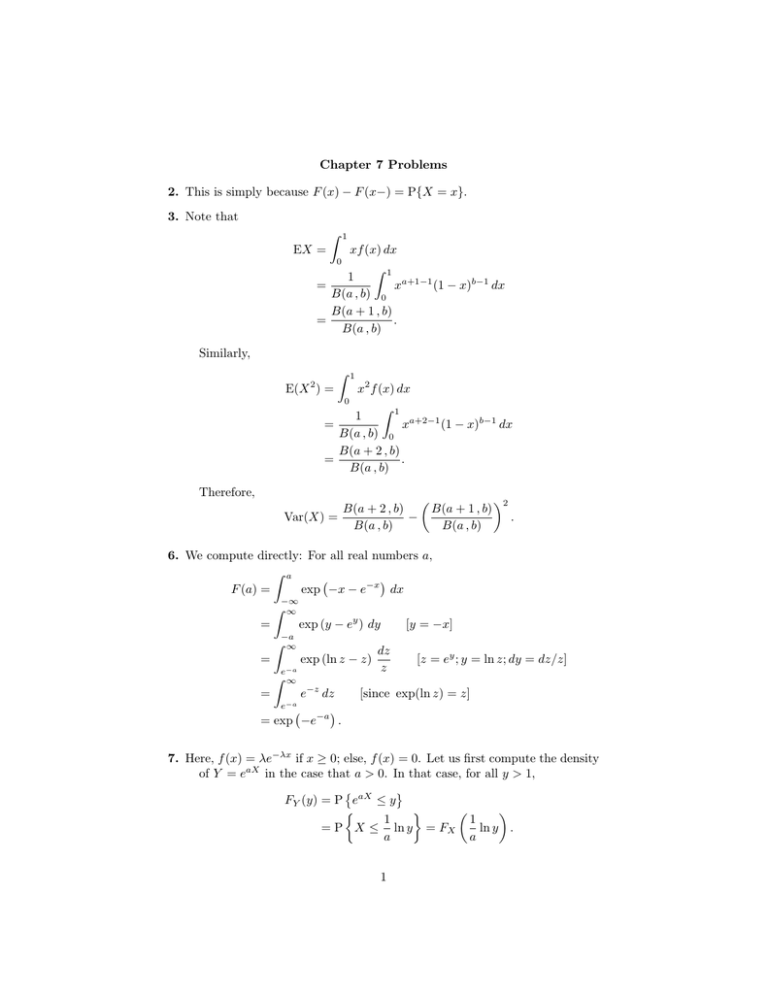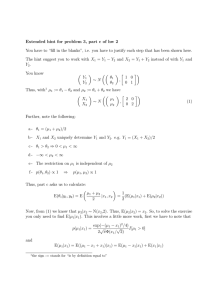Chapter 7 Problems 3. Note that Z
advertisement

Chapter 7 Problems
2. This is simply because F (x) − F (x−) = P{X = x}.
3. Note that
1
Z
EX =
xf (x) dx
0
Z 1
1
xa+1−1 (1 − x)b−1 dx
B(a , b) 0
B(a + 1 , b)
=
.
B(a , b)
=
Similarly,
Z
2
E(X ) =
1
x2 f (x) dx
0
Z 1
1
xa+2−1 (1 − x)b−1 dx
B(a , b) 0
B(a + 2 , b)
.
=
B(a , b)
=
Therefore,
Var(X) =
B(a + 2 , b)
−
B(a , b)
B(a + 1 , b)
B(a , b)
2
.
6. We compute directly: For all real numbers a,
Z a
F (a) =
exp −x − e−x dx
−∞
Z ∞
=
exp (y − ey ) dy
[y = −x]
−a
Z ∞
dz
[z = ey ; y = ln z; dy = dz/z]
=
exp (ln z − z)
z
−a
e
Z ∞
=
e−z dz
[since exp(ln z) = z]
−a
e
= exp −e−a .
7. Here, f (x) = λe−λx if x ≥ 0; else, f (x) = 0. Let us first compute the density
of Y = eaX in the case that a > 0. In that case, for all y > 1,
FY (y) = P eaX ≤ y
1
1
= P X ≤ ln y = FX
ln y .
a
a
1
Therefore, whenever y > 1,
1
1
λ
λ
λ −λ/a
λ
fY (y) =
fX
ln y =
exp − ln y =
y
= y −(λ/a)−1 .
ay
a
ay
a
ay
a
Else, fY (y) = 0 if y ≤ 1. Consequently,
Z
∞
EY =
1
λ
λ
y y −(λ/a)−1 dy =
a
a
∞
Z
y λ/a
1
λ/a
dy = 1 + (λ/a)
∞
1
if λ > a,
otherwise.
If, on the other hand, a < 0, then aX ≥ 0, and this means that 0 ≤ Y ≤ 1
with probability one. That is, for all 0 < y < 1,
FY (y) = P eaX ≤ y
1
1
ln y .
= P X ≥ ln y = 1 − FX
a
a
Therefore,
λ −(λ/a)−1
− y
fY (y) =
a
0
if 0 < y < 1,
otherwise.
In this case,
λ
EY =
a
Z
1
y
−λ/a
0
λ/a
dy = 1 − (λ/a)
∞
if 0 < λ < a,
otherwise.
15. For all c,
h
i
2
E (X − c) = E(X 2 ) − 2cEX + c2 ,
provided that E(X 2 ) < ∞. Call this expression f (c) and note that
f 0 (c) = −2EX + 2c
f 00 (c) = 2.
This implies that f is minimized at cmin = EX. Also,
h
i
2
f (cmin ) = E (X − EX) = Var(X).
Chapter 8 Problems
4. We know that for all a ≥ 0,
Z
a
Z
FX+Y (a) =
a−y
g(x + y) dx dy.
0
0
2
Note that for all y fixed, the inner integral is equal to:
Z a
Z a−y
g(z) dz.
[z = x + y]
g(x + y) dx =
y
0
Therefore,
Z
a
a
Z
Z
a
Z
0
y
Z
dy g(z) dz =
g(z) dz dy =
FX+Y (a) =
z
0
0
a
zg(z) dz.
0
by reversing the order of the two integrals. Consequently,
(
zg(z) if z ≥ 0,
fX+Y (z) =
0
otherwise.
5(b). We know from our previous assignment that c = 1/(2π), and so
f (x , y) =
1
3/2
2π (1 + x2 + y 2 )
.
Integrate [dy] to find that
Z ∞
1
1
fX (x) =
dy
2π −∞ (1 + x2 + y 2 )3/2
Z ∞
p
1
1
=
1 + x2 dz
3/2
2π −∞ (1 + x2 + (1 + x2 )z 2 )
Z ∞
dz
C
1
=
,
=
2π(1 + x2 ) −∞ (1 + z 2 )3/2
1 + x2
[z = y/
p
1 + x2 ]
for some C which does not depend on x. It follows then that X is Cauchy,
and C = 1/π (why?).
6. First, note that
w
.
1 + z2
Here, we are interested over the range x, y ≥ 0. Therefore,
r
r
w
w
x=
and y = xz = z
.
1 + z2
1 + z2
z 2 x2 = w − x2
⇒
x2 =
Now,
1
1
∂x
=
=
,
∂w
∂w/∂x
2x
Also,
∂x
1
x2
=
=− .
∂z
∂z/∂x
y
3
Similarly,
∂y
1
1
=
=
,
∂w
∂w/∂y
2y
and
∂y
1
1
=
= .
∂z
∂z/∂y
x
Therefore,
∂x ∂y ∂x ∂y
−
∂w ∂z ∂z ∂w
2
1
1
x
1
=
×
− − ×
2x x
y
2y
2
2
2
x
x +y
1
.
= 2+ 2 =
2x
2y
2x2 y 2
J(w , z) =
Solve for (w , z) instead of (x , y): x2 + y 2 = w2 ; and
x2 y 2 =
w
z2w
wz 2
×
=
.
1 + z2
1 + z2
(1 + z 2 )2
Therefore,
J(w , z) =
w2
1
z2
= w3
.
2
2
2
2(1 + z ) /wz
2 (1 + z 2 )2
Now plug to find that
z2
1 3
w
fX,Y (x , y)
2 (1 + z 2 )2
1
z2
1
= w3
2 (1 + z 2 )2 2π (1 + x2 + y 2 )3/2
fW,Z (w , z) =
=
z2
w3
1
.
4π (1 + z 2 )2 (1 + w2 )3/2
In particular, W and Z are independent, since fW,Z (w , z) is the product
of a function of w and a function of z; why does this do the job?
10. Solve for x and y to obtain:
x=
u+v
,
2
y=
u−v
.
2
Therefore,
J(u , v) =
∂x ∂y ∂x ∂y
1
−
=− ,
∂u ∂v
∂v ∂u
2
and therefore,
1
fU,V (u , v) = fX,Y
2
4
u+v u−v
,
2
2
.
If X = N (0 , σ 2 ) and Y = N (0 , τ 2 ), then
2 2 y
1
x
−
.
fX,Y (x , y) =
exp −
2πστ
2σ 2
2τ 2
And hence,
fU,V (u , v) =
1
(u − v)2
(u + v)2
−
.
exp −
4πστ
8σ 2
8τ 2
If τ 6= σ, then this cannot be written as a function of u times a function
of v. Therefore, U and V are not independent.
Else, if τ = σ, then
1
1 2
2
fU,V (u , v) =
exp − 2 (u + v) + (u − v)
4πσ 2
8σ
1 −u2 /4σ2 −v2 /4σ2
e
e
.
=
4πσ 2
This has the correct product form, so U and V are independent in this
case.
5




